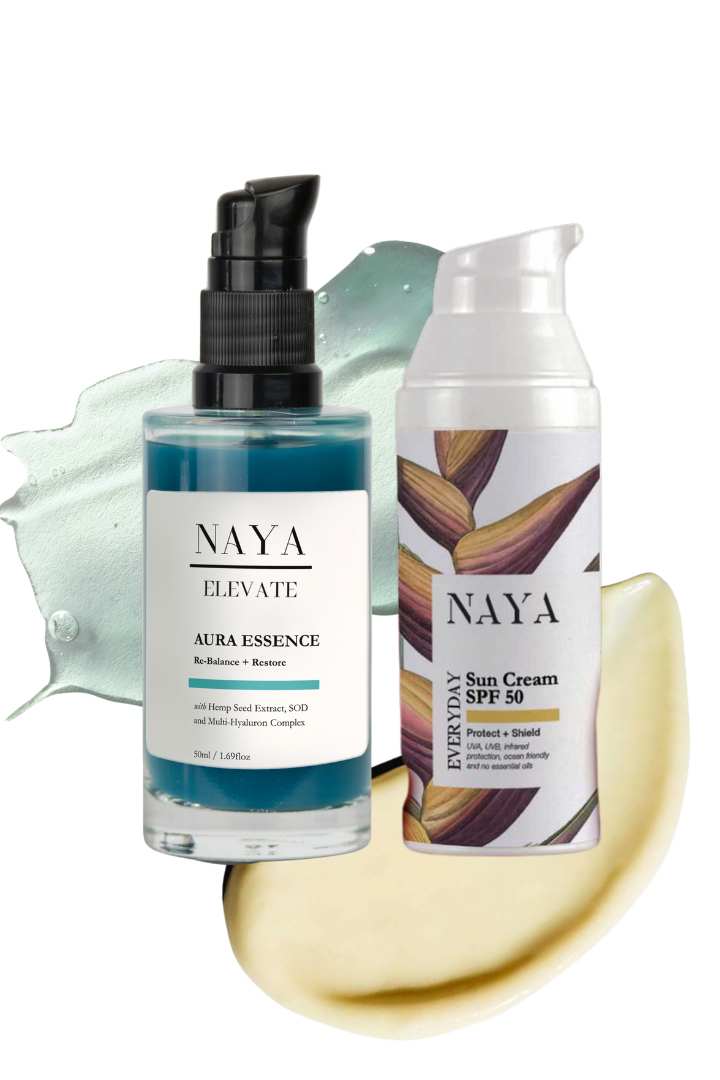The Ultimate Guide to Hyperpigmentation: Causes, Prevention, and Effective Treatments
Understanding Hyperpigmentation and How to Treat It Effectively
Hyperpigmentation is one of the most common skin concerns, affecting individuals of all skin types and tones. It appears as dark spots, patches, or uneven skin tone, caused by an overproduction of melanin. While hyperpigmentation is not harmful, it can be challenging to treat.
In this guide, we’ll explore how hyperpigmentation forms, how to prevent it, and the most effective skincare ingredients to combat it — plus why Vitamin C isn’t the one magical solution often claimed.
How Hyperpigmentation and Dark Spots Develop
The skin’s pigment, melanin, is produced by melanocytes through a process called melanogenesis. This process can be triggered by various factors, including:
-
UV exposure
-
Hormonal changes
-
Inflammation
-
Skin injuries
Some triggers you can influence, others (like hormonal changes) are more challenging to control.
Step-by-Step Melanin Production Process:
1. Activation of Tyrosinase (Minutes to Hours)
-
UV exposure, inflammation, or hormonal triggers activate tyrosinase, an enzyme responsible for melanin production.
-
Tyrosinase catalyses the conversion of L-tyrosine into L-DOPA and then into dopaquinone.
2. Formation of Melanin Precursors (Hours)
-
Dopaquinone transforms into melanin intermediates such as dopachrome and 5,6-dihydroxyindole (DHI).
3. Melanin Polymerisation and Storage (Hours to Days)
-
These intermediates polymerise into eumelanin (brown-black pigment) or pheomelanin (yellow-red pigment).
-
Melanin is stored in melanosomes within melanocytes.
4. Transfer of Melanin to Skin Cells (Days)
-
Melanosomes are transferred to keratinocytes, leading to visible pigmentation on the skin’s surface.
5. Appearance of Dark Spots (Days to Weeks)
-
As melanin accumulates in the upper skin layers, dark spots and uneven tone become visible.
Preventing Pigmentation: Daily Habits That Protect Skin
Preventing hyperpigmentation is key to maintaining an even skin tone.
Best Preventive Measures
-
Daily Sunscreen Use: UV exposure is the leading cause of pigmentation. Broad-spectrum SPF 30+ protects against UVA and UVB, reducing tyrosinase activation.
-
Avoid Skin Trauma: Picking at acne, over-exfoliating, or using harsh treatments can trigger post-inflammatory hyperpigmentation (PIH).
-
Manage Hormonal Changes: Conditions like melasma are influenced by hormonal fluctuations. Seek advice on how to balance hormones.
-
Use Anti-Inflammatory Skincare: Soothing actives help minimise inflammation-related pigmentation.
💡 Tip: Browse our Uneven Skin Tone & Dark Spots solutions for targeted prevention and treatment.
Why Vitamin C Isn’t the Ultimate Pigmentation Solution
Vitamin C is often praised as a must-have for brightening and fading dark spots. While it’s a valuable antioxidant, it’s not the magic cure many believe.
Limitations of Vitamin C in Pigmentation:
-
Instability: L-ascorbic acid, the most potent form, degrades quickly when exposed to light, air, or heat. Many formulas lose effectiveness before reaching your skin.
-
Limited Power on Stubborn Pigmentation: Vitamin C can inhibit tyrosinase but struggles to reverse deep-set pigmentation alone.
Conditions like melasma or PIH often require a multi-active approach with ingredients like Niacinamide, Potassium Azeloyl Diglycinate, Tranexamic Acid, and Retinoids — which target pigmentation through multiple pathways.
Best Ingredients to Reduce Pigmentation and Fade Dark Spots
Effective pigmentation treatments work by targeting different steps of melanogenesis:
1. Inhibiting Tyrosinase Activity
-
Alpha-Arbutin – A safe alternative to hydroquinone that directly inhibits tyrosinase.
-
Tranexamic Acid – Reduces melanin production by calming melanocyte activation from UV exposure.
-
Licorice Extract (Glabridin) – Suppresses tyrosinase and reduces inflammation.
-
Resorcinol Derivatives (e.g., Hexylresorcinol) – Potent tyrosinase inhibitors with antioxidant effects.
2. Blocking Melanin Transfer
-
Niacinamide (Vitamin B3) – Prevents melanin transfer to keratinocytes.
-
Soy Isoflavones – Downregulate melanin synthesis pathways.
3. Breaking Down Existing Pigment
-
Vitamin C (L-Ascorbic Acid) – Reduces oxidised melanin intermediates and brightens skin.
-
Potassium Azeloyl Diglycinate – Inhibits tyrosinase and soothes inflammation.
-
Cysteamine – Reduces melanin synthesis by lowering dopaquinone levels.
4. Accelerating Skin Cell Turnover
-
Retinol / Retinal – Stimulate cell renewal to fade pigmentation faster.
-
Exfoliating Acids (AHAs, BHAs, PHAs) – Remove pigmented cells from the surface.
-
AHAs (glycolic, lactic): most effective for resurfacing.
-
BHAs (salicylic): helpful for acne-related pigmentation.
-
PHAs (gluconolactone): gentler for sensitive skin.
-
Pigmentation Skincare Routine: Morning and Evening Steps
Morning Routine
-
Cleanser – Gentle, pH-balanced.
-
Serum – Tranexamic Acid, Potassium Azeloyl Diglycinate, Niacinamide.
-
Moisturiser – Lightweight, barrier-supportive.
-
Sunscreen SPF 50+ – Broad-spectrum, ideally with antioxidants.
Evening Routine
-
Cleanser – Gentle or double cleanse if wearing makeup.
-
Serum – Retinal/Retinol + Tranexamic Acid.
-
Moisturiser – Ceramide-rich to support overnight repair.
What to Avoid When Treating Pigmentation
-
Skipping Sunscreen – Without SPF, treatment will fail.
-
Low UVA Protection – High SPF with poor UVA coverage won’t protect pigmentation.
-
Harsh Exfoliation – Overuse of acids or scrubs worsens PIH.
-
Irritating Ingredients – Fragrance, alcohol, certain essential oils can inflame skin. I don't understand many influencers & co are suggesting sunscreens with fragrances, alcohol and essential oils as well as serums that are meant to prevent hyperpigmentation and than are full of fragrances & co. Not helpful but you see the marketing story here.
-
Unverified DIY Remedies – Lemon juice, apple cider vinegar, and DIY sunscreens can damage skin.
Is Pigmentation Easier to Treat in Lighter Skin?
Caucasian skin tends to respond more quickly to hyperpigmentation treatments due to:
-
A faster cell turnover rate.
-
Less risk of post-inflammatory hyperpigmentation (PIH) compared to darker skin tones.
-
More effective penetration of active ingredients due to a thinner stratum corneum.
However, individuals with fair skin are more prone to UV-induced pigmentation and must prioritise sun protection. For darker skin tones, treatments must be gentler to avoid irritation-induced pigmentation.
Final Thoughts on Pigmentation Treatment
Hyperpigmentation is a complex skin concern that requires a multi-faceted approach. The key to effective treatment lies in:
-
Prevention: Consistent sunscreen use and avoiding skin trauma.
-
Targeted Treatment: Using ingredients that inhibit tyrosinase, block melanin transfer, and accelerate skin renewal.
-
Patience and Consistency: Results take time, usually 6-12 weeks, with diligent skincare and habits.
For targeted solutions, explore our Uneven Skin Tone & Dark Spots collection or learn more about Retinal vs Retinol in our ingredient guide.
1. FAQs
Q: What is the best treatment for pigmentation?
A: The best pigmentation treatments use a combination of actives such as Tranexamic Acid, Alpha-Arbutin, Retinal, and Niacinamide to target melanin production, block pigment transfer, and speed up cell turnover.
Q: How can I fade dark spots quickly?
A: For faster results, use a multi-pathway approach: daily SPF 50+, brightening actives like Tranexamic Acid and Alpha-Arbutin, and exfoliants such as AHAs or Retinal to remove pigmented cells.
Q: Does Vitamin C work for pigmentation?
A: Vitamin C can help prevent pigmentation by inhibiting tyrosinase and reducing oxidative stress, but it’s not strong enough to reverse stubborn pigmentation on its own. Combining it with other brightening actives is more effective.
Q: Can pigmentation be removed permanently?
A: Pigmentation can often be significantly reduced, but without consistent sun protection and maintenance skincare, it may return. Long-term results depend on prevention as much as treatment.
Q: Is pigmentation easier to treat in lighter skin?
A: Lighter skin may respond more quickly to pigmentation treatments due to faster cell turnover and lower PIH risk, but it is more prone to UV-induced pigmentation. Darker skin tones require gentler approaches to avoid irritation-triggered pigmentation.











Leave a comment